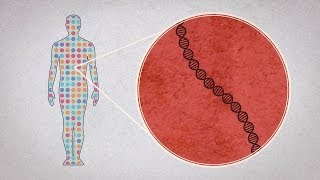(单词翻译:单击)
You've probably heard of the human genome, the huge collection of genes inside each and every one of your cells.
你大概听说过人类基因组,它是巨量的基因总和,在你的每一个细胞里都有一份。
You probably also know that we've sequenced the human genome, but what does that actually mean?
你很可能也知道,我们已经对人类基因组进行了测序,但这到底是什么意思?
How do you sequence someone's genome? Let's back up a bit.
怎样对一个人的基因组进行测序呢?我们先讲点背景知识。
What is a genome? Well, a genome is all the genes plus some extra that make up an organism.
什么是基因组?基因组,就是全部的基因再加上点别的共同组成了有机体。
Genes are made up of DNA, and DNA is made up of long, paired strands of A's, T's, C's, and G's.
基因由DNA组成,而DNA是成对的长链,由A(腺嘌呤),T(胸腺嘧啶),C(胞嘧啶)和G(鸟嘌呤)组成。
Your genome is the code that your cells use to know how to behave.
你的基因组是一组代码,你的细胞要通过它来知道自己该做什么。
Cells interacting together make tissues. Tissues cooperating with each other make organs.
细胞交织在一起成为组织,不同的组织协调构成了器官。
Organs cooperating with each other make an organism, you!
器官间协同工作则形成了有机体,就是你!
So, you are who you are in large part because of your genome.
所以,你之所以是你,很大程度上原因在于你的基因组。
The first human genome was sequenced ten years ago and was no easy task.
第一个人类基因组测序完成于十年前,非常艰难。
It took two decades to complete,
它花了20年才完成,
required the effort of hundreds of scientists across dozens of countries, and cost over three billion dollars.
需要来自几十个国家的几百位科学家付出了辛劳,而且费用超过30亿美元。
But some day very soon, it will be possible to know the sequence of letters that make up your own personal genome
但不久的一天,搞清组成你这个人的基因组的字母排列将成为可能,
all in a matter of minutes and for less than the cost of a pretty nice birthday present.
只要几分钟,费用还不及一份不错的生日礼物贵。
How is that possible? Let's take a closer look.
这怎么可能呢?让我来解释一下。
Knowing the sequence of the billions of letters that make up your genome is the goal of genome sequencing.
搞清组成你的基因组的几十亿个字母排列,是基因组测序的目标。
A genome is both really, really big and very, very small.
基因组既很大很大,又很小很小。
The individual letters of DNA, the A's, T's, G's, and C's, are only eight or ten atoms wide,
DNA的每个字母,就是A、T、G、C,宽度只有8到10个原子,
and they're all packed together into a clump, like a ball of yarn.
而他们全部缠在一起成为一团,像一团毛线。
So, to get all that information out of that tiny space,
所以,要从这么小的地方获取所有这些信息,
scientists first have to break the long string of DNA down into smaller pieces.
科学家首先要把DNA的长链打断为许多短链。
Each of these pieces is then separated in space and sequenced individually, but how?
然后把每一段分离出来单独测序,怎么测?
It's helpful to remember that DNA binds to other DNA if the sequences are the exact opposite of each other.
这样想一下会更容易理解:DNA会和其它DNA交合,如果彼此的序列刚好互补的话。
A's bind to T's, and T's bind to A's. G's bind to C's, and C's to G's.
A配T,T配A。G配C,C配G。
If the A-T-G-C sequence of two pieces of DNA are exact opposites, they stick together.
如果两片DNA的序列ATGC刚好互补,它们就会结合在一起。

Because the genome pieces are so very small,
因为基因组片段非常小,
we need some way to increase the signal we can detect from each of the individual letters.
我们需要某些办法来放大信号,这样才能检测到每个字母是什么。
In the most common method, scientists use enzymes to make thousands of copies of each genome piece.
科学家最常用的方法,是用酶来合成几千份基因副本,
So, we now have thousands of replicas of each of the genome pieces, all with the same sequence of A's, T's, G's, and C's.
这样我们就有了每一个基因组几千份复制品,全部都有一样的ATGC序列。
But we have to read them all somehow.
但我们还得把全部的序列读出来。
To do this, we need to make a batch of special letters, each with a distinct color.
为了做到这一点,我们需要制作一批特别字母,每种都有特殊的颜色。
A mixture of these special colored letters and enzymes are then added to the genome we're trying to read.
把这些带颜色标记的字母和酶混合在一起,再加入到我们试图阅读的基因组里。
At each spot on the genome, one of the special letters binds to its opposite letter,
在基因组的每一个点上,有一个特殊字母和对应的字母结合,
so we now have a double-stranded piece of DNA with a colorful spot at each letter.
这样就有了一段双链DNA,并且在每个字母上都有颜色标记。
Scientists then take pictures of each snippet of genome.
然后科学家对每一小段基因组照相。
Seeing the order of the colors allows us to read the sequence.
看到了颜色的排列顺序,我们就可以读出序列。
The sequences of each of these millions of pieces of DNA are stitched together using computer programs
这样几百万条DNA片段的序列是由计算机程序拼接一起的
to create a complete sequence of the entire genome.
这样就得到了整个基因组的完整序列。
This isn't the only way to read the letter sequences of pieces of DNA, but it's one of the most common.
这并非读取DNA片段序列字母的唯一方法,却是最常用的方法之一。
Of course, just reading the letters in the genome doesn't tell us much.
当然,仅仅是读取了基因组中的字母还远远不够。
It's kind of like looking through a book written in a language you don't speak.
就好像你在翻一本书,书中所用的语言你并不懂。
You can recognize all the letters but still have no idea what's going on.
你能读出书里的每个字母,却仍然不理解书里说什么。
So, the next step is to decipher what the sequence means, how your genome and my genome are different.
所以,下一步就是解码,序列到底是什么意思,为什么你的基因组和我的不一样。
Interpreting the genes of the genome is the part scientists are still working on.
阐释基因组中的不同基因的功能,是科学家正在进行的工作。
While not every difference is consequential,
虽然并不是每一处不同之处都意义重大,
the sum of these differences is responsible for differences in how we look, what we like, how we act,
但这些不同之处组合在一起决定了人与人之间的不同。它决定了我们怎么看,我们喜欢什么,我们如何反应,
and even how likely we are to get sick or respond to specific medicines.
甚至我们患上疾病的可能性,或是对特定药物的反应。
Better understanding of how disparities between our genomes account for these differences
更好地了解我们各自的基因组有哪些差别,
is sure to change the way we think not only about how doctors treat their patients, but also how we treat each other.
必将改变我们的观念:不光是医生应当如何治疗病人,还有我们该如何对待他人。


